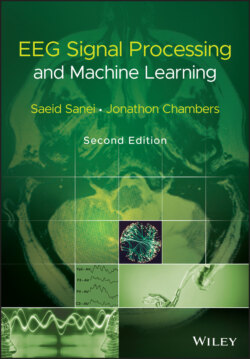Читать книгу EEG Signal Processing and Machine Learning - Saeid Sanei - Страница 33
2.9 Mental Disorders 2.9.1 Dementia
ОглавлениеDementia is a syndrome that consists of a decline in intellectual and cognitive abilities. This consequently affects the normal social activities, mode, and the relationship and interaction with other people [44]. EEG is often used to study the effect of dementia. In most cases such as in primary degenerative dementia, e.g. Alzheimer's, and psychiatric disorder, e.g. depression with cognitive impairment, the EEG can be used to detect the abnormality [45].
In [45] dementia is classified into cortical and subcortical forms. The most important cortical dementia is Alzheimer's disease (AD), which accounts for approximately 50% of the cases. Other known cortical abnormalities are Pick's disease and CJD. They are characterized clinically by findings such as aphasia, apraxia, and agnosia. CJD can often be diagnosed using EEG signals. Figure 2.13 shows a set of EEG signals from a patient with CJD. Conversely, the most common subcortical diseases are Parkinson's disease, Huntington's disease, lacunar state, normal pressure hydrocephalus, and progressive supranuclear palsy. These diseases are characterized by forgetfulness, slowing of thought processes, apathy, and depression. Generally, subcortical dementias introduce less abnormality to the EEG patterns than the cortical ones.
In AD, the EEG posterior rhythm (alpha rhythm) slows down and the delta and theta wave activities increase. Conversely, beta wave activity may decrease. In the severe cases epileptiform discharges and triphasic waves can appear. In such cases, cognitive impairment often results. The spectral power also changes; the power increases in delta and theta bands and decreases in beta and alpha bands and also in mean frequency.
The EEG wave morphology is almost the same for AD and Pick's disease. Pick's disease involves the frontal and temporal lobes. An accurate analysis followed by an efficient classification of the cases may discriminate these two diseases. CJD is a mixed cortical and subcortical dementia. This causes slowing of the delta and theta wave activities and, after approximately three months of the onset of the disease, periodic sharp wave complexes are generated which occur almost every second, together with decrease in the background activity [45]. Parkinson's disease is a subcortical dementia, which causes slowing down of the background activity and an increase of the theta and delta wave activities. Some works have been undertaken using spectral analysis to confirm the above changes [46]. Some other disorders such as depression have lesser effect on the EEGs and more accurate analysis of the EEGs has to be performed to detect the signal abnormalities for these brain disorders.
Generally, EEG is usually used in the diagnosis and evaluation of many cortical and subcortical dementias. Often it can help to differentiate between a degenerative disorder such as AD, and pseudodementia due to psychiatric illness [45]. The EEG may also show whether the process is focal or diffuse (i.e. involves the background delta and theta wave activities). The EEG may also reveal the early CJD‐related abnormalities. However, more advanced signal processing and quantitative techniques may be implemented to achieve robust diagnostic and monitoring performance.
Figure 2.13 A set of multichannel EEG signals from a patient suffering from CJD.
